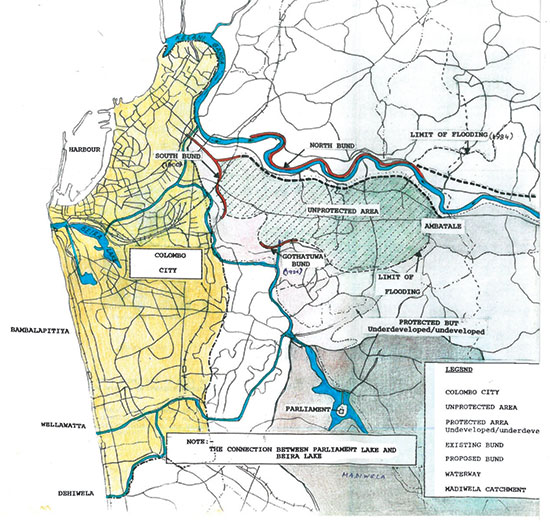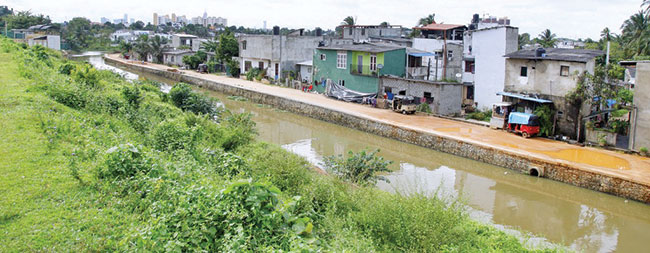Features
After a 50-year Comedy of Errors

Kelani Flood Memories
BY Eng Anton Nanayakkara
Senior Deputy Director of Irrigation (retd)
With October rains gradually easing off and while many members of poor families are still seen standing in queues for gas, kerosene and essential food items, the writer of this piece had the most unexpected surprise of being invited to see the present state of the familiar Gothatuwa Flood bund (also called Howard Bund) built by the British in 1924 as the last step in protecting Colombo from flooding, combined with the 18th century Dutch built Kollonnawa Bunds, the invitation which I gladly accepted..
After a gap of about 50 years this invitation was most welcome because it was bound to bring many memories, both good and bad, old and new, in recalling, the writer’s bygone efforts, one of which was to propose a sensible plan of development for this large area, about three times the size of the present city of Colombo, existing beside the city of Colombo, one of which was the Creation of a New City..
Among the bad memories was the inevitable recalling of the horror of a sleepless night of the 2nd of October major flood of 1967., when the writer was ordered on compulsory flood duty to ensure the safety of this same bund. The team comprised of one engineer (myself) one technical assistant and a solitary cop and a torch and a cadjan hut with a telephone.. That whole night was really scaring with the soundless darkness of the night only to be broken by the sound and dim light of Navy boats bringing dead bodies and dumping them on the bund which we were guarding. The flood level was just about three feet below the bund top level where we were on duty and the sound of waves beating on the bund, too, was unnerving. (note the flood level was 9.17’ at Nagalagam Gauge according to Irrigation Department data.} So much for 1967.
Then, many years later, in 1984, the writer, as Deputy Director in charge of Colombo, recalled how the entire area between this bund and the river was designated as ‘unprotected area’ (see plan) coming under the jurisdiction of the Irrigation Department. No building whatsoever were permitted without the permission of the Irrigation Department These memories gave a good start for the journey..

Then the good memories centred round the proposal made by the writer, soon after the above flood of 1984, proposing an alternate location for the south bund which was widely accepted by all heads of relevant organisations and the proposal to convert the newly protected area into a modern state-of-the-art New City that will surpass Singapore, quoting many examples of new cities existing elsewhere such as Islamabad (Pakistan), Manila Makarty (Philippines), New Seoul (South Korea), Dallas Fort Worth (USA), Milton Keynes (England) Osaka Nara Kyoto (Japan), Abuja (Nigeria), Schenzgen (South China) were given to support the proposal.
Going a step further, equally fascinating examples of many cities, where rivers have enhanced the beauty of such cities, such as River Thames (London), River Rhine (Koln), River Danube (Vienna) River Nile (Cairo) River Volga (St Petersburg), River Seine (Paris) were also given. In comparison, what we have been doing with the beautiful Kelani River, running by the side of our Capital City of Colombo, is left for the reader to guess.? After showing all these supporting examples, the efforts to promote the concept of New City of Colombo Project sadly fell on deaf ears.
But the worst experience of the day was seeing the existing state of this same unprotected area just below the Gothatuwa bund after 50 years covered with hundreds of unauthorised structures in the unprotected area (an insult for the New City proposal) leaving only God to tell us who on earth gave permission to build these idiotic constructions in the unprotected area some parts appearing to be the work of an unknown government agency .
This horrible sight (shown in picture) as well as the experience of seeing so many other unwanted structures in the Colombo City––pump houses, tunnels, new canals unwanted bridges, etc.,–– has left the writer wondering how the future generations of this country will judge these white elephants which have cost millions of dollars.
The subject of Kelani Ganga is supposed to have been raised once again in Parliament at a COPE Committee meeting this year hopefully for a fresh start.